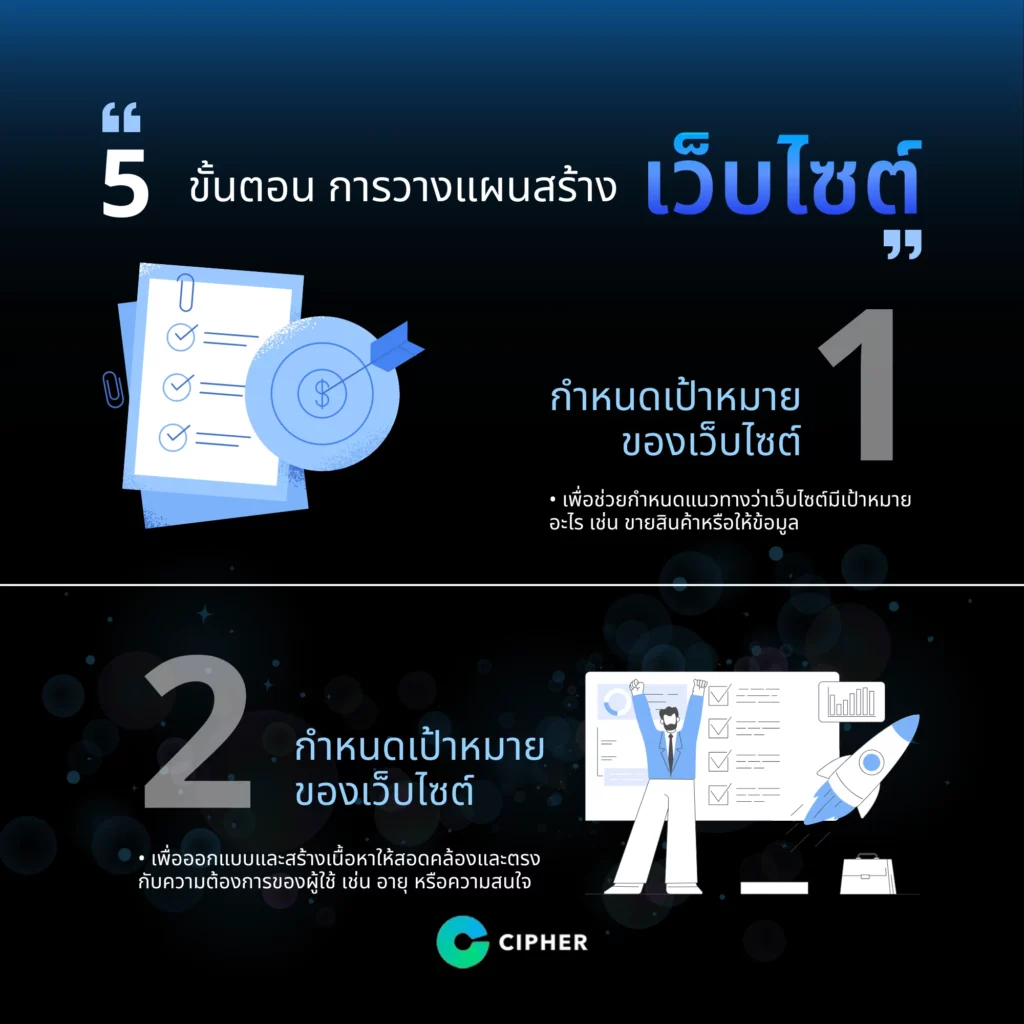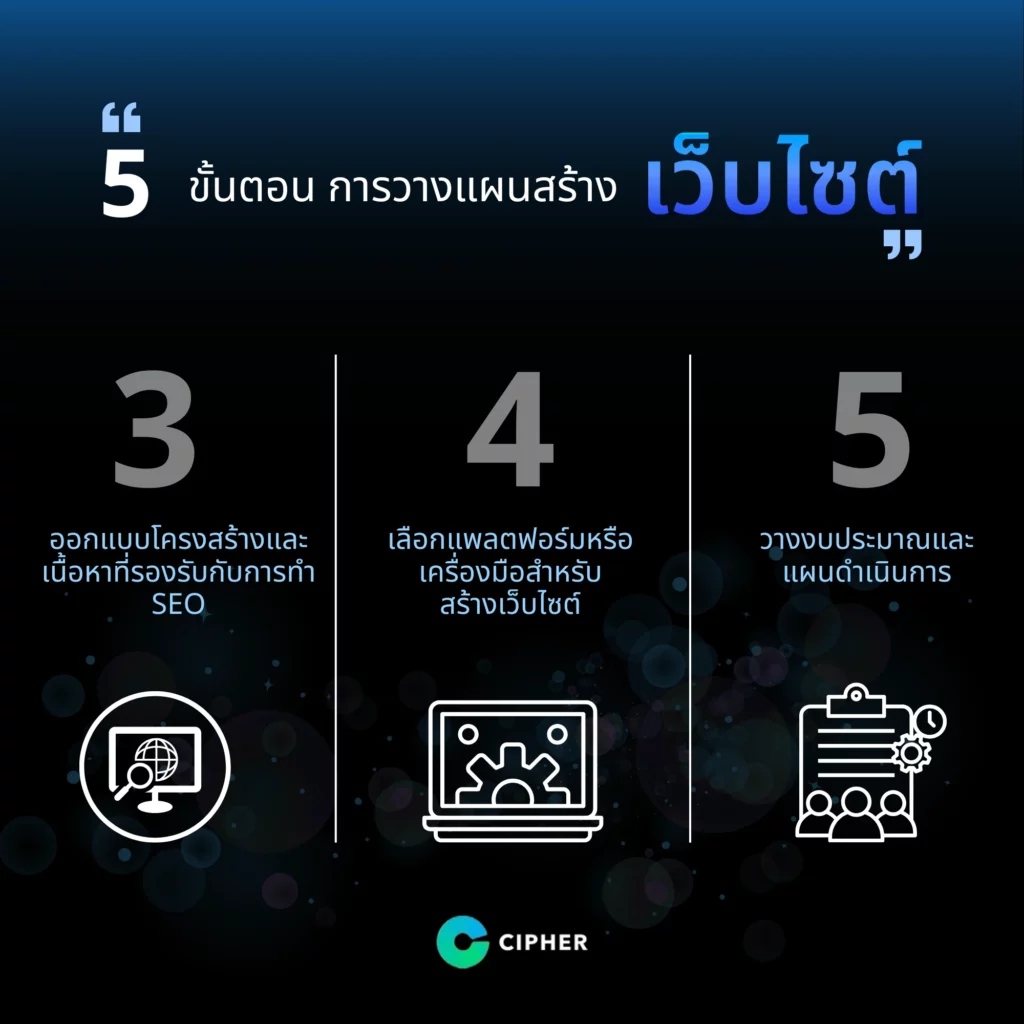Table of Contents
Five steps to plan a website Before you start a website, you need to know it. Anything?
“Site” is a window to the digital world for modern businesses. The website is not just an online channel, but an important tool to build identity and credibility for organizations. Designing the website is essential by making effective SEOs that can help you create more awareness and reach your target audience. At the same time, create a professional image for your business.
Building a website is not just about having a beautiful online face. Before building a website, careful planning is needed to meet customer needs and meet business needs. In this article, you will take a closer look at the “Site Planning Process” to ensure your website is successful!
Do entrepreneurs need their own websites? ?
Online marketing has now become a challenge for all types of businesses. As people change, technology becomes more important, businesses must adapt to the times and create their own websites, not just as an option, but as a necessity for businesses and entrepreneurs. The main reasons that entrepreneurs need to have their own website are as follows:

- Build business credibility: The website is like an online storefront that shows the brand’s identity and image. Having a professionally designed website helps build trust for customers.
- It is a source of information that customers can search for: Most customers search the Internet before making a decision to buy or use a product. The availability of websites allows customers to access products and services at any time increases their sales opportunities.
- Create more sales channels: While using social media platforms such as Facebook or Instagram can promote products and reach target audiences, if the account is blocked or algorithms change, having their own website will not lose market and sales opportunities.
- Increase awareness: SEO-optimized websites can help your brand or business appear in search results such as Google or Bing, allowing you to reach more target groups without advertising fees.
- Supporting future business expansion: The process of analyzing and planning an e-commerce business by building a website for future business expansion is commonly used by most brands or businesses to support business changes.
The content elements of the website are: Anything?
A good website should have a clear and easy-to-use structure. The main content of the website is an important part of making the website more complete. It can be divided into 3 important parts: Page Header, Page Body, and Page Footer, each with the following details:
1. Page Header
The homepage is the starting point for users to see first when they visit the website. The homepage will be responsible for helping guide and communicate the brand’s identity, which will consist of
- Logo: It is an important part of the brand’s identity.
- Navigation Menu: Links to various parts of the website, such as the Home Page, Products/Services, About Us, and Contact Us.
- Search Bar: makes it easier for users to find the information they want.
- Call-to-Action: for example, subscription, order, or login buttons.
- Contact: e.g. phone number or social media icon
2. Page Body (Page Body)
Content is the main part used for presenting information that users want to know. Overall, the content should have Lay Out positioned to organize information and elements. The content will consist of important parts as follows:
- Main topic (Headline): should be clear and attract attention.
- Text and content: Easy-to-understand text should be used to communicate information about products, services or messages that businesses want to offer.
- Photos or videos: These elements will enhance content to be easier to understand and more interesting.
- Graphics or Animation: Use interesting graphics to enhance modernity and appeal to the eyes.
- Active call (CTA): For business sites, you should place the CTA button on the content relevant to the product or service to encourage users to take actions such as downloading documents or purchasing goods.
3. End (Page Footer)
The end is a summary of important information and additional channels for users. In the process of planning a website, some people may ignore this part, which should not be overlooked because it is another part that helps to verify their identity and build trust in the brand or business. The end will consist of:
- Contact information: such as address, phone number, and email
- Important links: e.g. privacy policy or terms of use of the service
- Social media channels: links to social media such as Facebook, Instagram, or LinkedIn.
- Copyright (Copyright Statement): e.g. “© 2024 Company Name. All rights reserved.”
Why Plan Before Building a Web Site?
Careful planning before developing the website is key to success for all businesses because today’s website is not just an online shop, it’s a key tool to build brand identities, drive sales and maintain customer relationships.
Lack of a clear plan can result in budget and time loss, as well as budget and time overloads. To make the site more efficient, let’s take a look at the five-tier site planning process that will make your site a success!
5 Site Planning Steps
Creating a website efficiently is not easy. Making planning a website is an important process that will help you get a website that meets your business and create a good experience for users. Here are five steps to plan a website that will make your website successful:

1. Target Sites
Targeting a website is important to set proper design, development and content management guidelines. Visitors to the website can see the overall picture of your website immediately. The main goals of the website can be divided into 3 main categories as follows:
- E-Commerce website: The website focuses on selling products and services through online channels, helping to increase sales and reduce business costs.
- Informational: A website to create awareness and provide information about brands, businesses or organizations that focus on providing valuable information or content that meets the needs of the target audience.
- Lead Generation: A website to attract new customers and increase contact channels, encouraging users to subscribe, ask for information or express interest.
2. Know your target audience.
Target group education is one of the key steps that helps your website address users’ needs. Whether you create a website to sell products, provide information or increase contact, understanding the target group in depth improves design and content to match their needs and behaviors, such as:
- Age group: age grouping helps you understand what the target group needs. What and what kind of interests are there to design a website that’s right for those people?
- Attention: Understanding the interests of the target audience allows you to create content and services that meet their needs, such as creating blogs or articles that match the interests of users.
- Online Behavior: An analysis of Internet behavior helps you understand how the target audience uses your site. For example, focus on mobile devices.
Knowing the target audience will help you design and manage content to meet your needs, create a positive user experience, not only will it increase the number of visitors, but it will also create a good relationship with the target audience in the long run.
3. Design structure and content supported with SEO
SEO-enabled website design or Search Engine Optimization not only means content tailored to search, but also site structure that makes it easy for users and search engines to access information. The key structures and content in each function should include:

- Number of pages and website structure: A good website structure should have a simple structure that allows users to access important pages within 2-3 clicks. Examples of page organization include Home, About, Contact or articles. Categorizing websites will make them easier to use.
- Key Content on each page: Organizing content and using keywords on each page, providing a positive user experience and easy access to search engines will increase your website’s chances of being ranked on the search results page.
4. Select the platform or tool for creating the site.
Choosing the right platform or tool for creating a website is important because a good platform allows you to quickly develop a website that is easy to use and meets the needs of businesses and organizations. Unique web-building platforms such as Shopify, WordPress, and the Internet. Wix or Coding should be considered based on the needs and goals of the website to enable the most efficient use of the website platform.
- Shopify: A platform designed specifically for building online stores. Shopify has the process of analyzing and planning an e-commerce business by creating a website that is easy to use and suitable for businesses of all sizes.
- WordPress: It is the most popular platform because it is easy to use and customizable, supports SEO well. Google’s ranking improvement plug-in is ideal for blog sites and small to medium-sized business sites, and for newcomers who have never used WordPress, select companies with Template Design & Development services. It will make it easier to design the website.
- Wix: It is an easy-to-use drag-and-drop platform that requires no technical knowledge, less flexibility than WordPress, which is ideal for small businesses and personal websites or portfolios.
- Custom Coding: For those who need a highly personalized website or special features that are not available on a regular platform, coding experts are popular with large websites such as large enterprises or systems that require high security.
5. lay out a budget and implementation plan
Budgeting and implementation plans are important steps to create an efficient and cost-effective website. Detailed planning reduces the risk of problems and helps to achieve the site’s goals as follows:
- Web site development costs: Includes hiring developers or costs for website building tools such as WordPress, Wix or Shopify.
- Web Design Value: Hiring graphic designers or using pre-built themes
- Domain name and hosting values: annual cost for domain registration, for example. com, . Th and hosting rental.
- Tool and Plug-in Value: Additional costs for special features such as SEO systems, security systems, add-on plug-ins for specific business needs.
- Marketing and SEO Value: For promoting websites such as Google Ads ads, hiring SEO experts, or creating content.
- Maintenance cost: Sites require continuous maintenance for site updates and updates.
In addition, it is necessary to evaluate the requirements, select appropriate tools, and clearly define the duration of the work to achieve the target site and be able to use it in the long run.
What to Avoid When Building Sites
The process of building a website is a process that requires great care and planning. Without preparing or choosing the right approach, it can cause errors that adversely affect the website’s performance and user experience and things to avoid when starting a website, such as:
- Choosing the wrong platform or tool: Choosing the tool or platform that doesn’t fit the needs or types of business can complicate future site improvements.
- Overcomplex design: Complex site design, packed with unnecessary components, confuses users and sites are slow to load.
- Neglecting SEO: Ignoring the need to increase website performance to rank among search engines such as missing keywords or a good URL structure.
- Ignore the speed of loading websites: Slowly loading websites can cause users to leave the website before they see the content.
- Unimportant Mobile Responsiveness: Websites that do not support mobile use will take advantage of the opportunity of users coming from mobile devices.
To have their own website Why is CIPHER such a good choice for you?
CIPHER is an integrated website development and development specialist for quality websites that meet all business requirements with Web Design & Development services. We have web developers and experts who understand user-friendly UX/UI designs.
CIPHER is a great choice for creating a website that meets all dimensions, from quality design, SEO-enabled website development to excellent after-sales service. If you’re looking for effective website helpers and ready to take you to success, CIPHER is the perfect answer!
Summary
The Web Site Plan process is a key factor to facilitate website design or Web Design that is unique, easy to use and user friendly. Therefore, having your own website is not something that entrepreneurs should overlook. Whether your business is small or large, because the website helps build reliability and accessibility to customers. And support long-term business growth. If you don’t have a website, this is the perfect time to start building!
Frequently Asked Questions About Site Planning Steps
For brands or business owners who are looking to make your business known online or who are concerned about the process of analyzing and planning an e-commerce business by building a website for online stores, there may be questions about the process plan for creating the website.Steps to create a website are: Anything?
Many people think it’s easy to create a website. Just having good ideas is enough. In fact, creating a successful website requires more than that. To create a website, one must have the following forms of building a website:- Concept and Content: Focus on interesting, accurate and up-to-date content and create a concept that enhances the reliability and appeal of the target audience.
- Design: Design the website to be beautiful, concept-friendly and easy to use, taking into account the right color, font and graphics.
- Development: Development: Develop a website with a program that meets the target requirements to enable the website to work efficiently and to meet the needs of users.
What percentage of color is commonly used to design websites?
To design a website, choosing the right color ratio helps the website look balanced and interesting. Generally, 60-30-10, which divides the color ratio as follows:- Primary Color – 60%: Used as the basic color of the website, such as the background or main area of the presentation, helps create a mood and image for the website.
- Secondary Color – 30%: Used to enhance the primary color, such as the color of the menu, card, or information frame, making the website look more dimensional and interesting.
- Accent Color – 10%: Used in important points that need to attract attention, such as Call-to-Action buttons, links, or prominent
What is the structure of the website?
Website structure is an important factor that affects the success of the website. Each type of website will have a different structure and elements. It is divided into the following main sections:- Header: such as the logo, navigation menu, search area, or login/register button
- Content Area: such as the main content of the web page, images/videos Articles/Texts and Forms
- Sidebar: Submenus, Ads, Related Links and Widgets
- Footer: Contact Information, Important Links, Copyright and Social Media Channels





